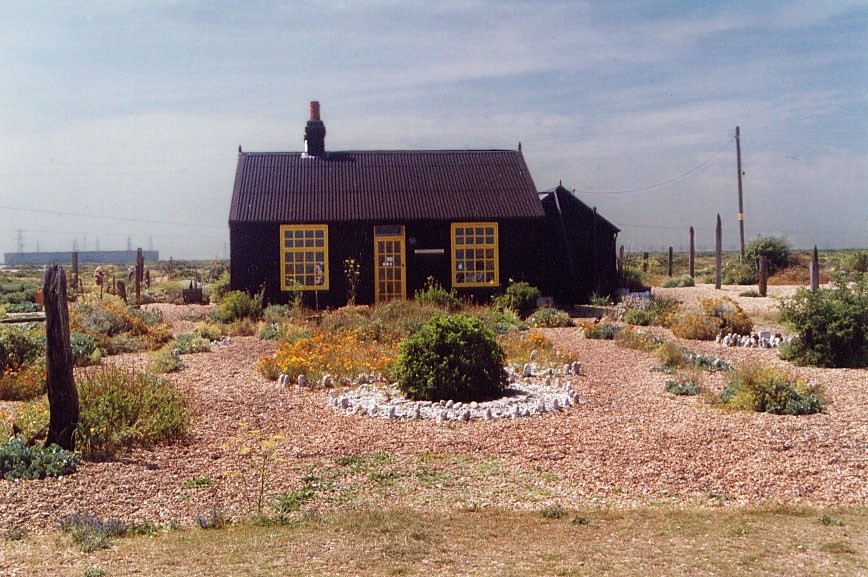As the auteur’s revealing journals are republished by Vintage Classics, we extract a poignant reflection about his love/hate relationship with clothes
“A peculiar blend of reflectiveness and fury,” wrote the New York Times of Derek Jarman’s 1991 film The Garden. It is a fever dream of a film, a restless assemblage of images tinted Jarman-esque hues: Madonna and child flee the paparazzi across Kent’s wild beaches; gay men are handcuffed, and tortured, then resurrected; a figure lies lifeless at the water’s edge, ringed with sacred flames. It is a film about being gay, and ill – in 1986, Jarman has been diagnosed with HIV; three years after The Garden was released, in 1994, he would pass away, following a lineage of friends and lovers already gone.
In 1989, though, when The Garden was presumably already circulating in his mind, Jarman began a diary. Modern Nature, as it would be published as, spans an almost two-year period as the film was being made. Modern Nature is about a garden too – that of Prospect Cottage, his home, which sits on the on the shingle shore of Dungeness, Kent, in the shadow of Dungeness B nuclear power station. Horticulture peppers the text: he names the many flowers he encounters – clematis, forsythia, japonica and camellias all bloom across the pages of Modern Nature – so too the wildlife and weather; where kestrels swirl in the sky and winds rush in from sea. Prospect Cottage becomes his own kind of Eden. “Paradise haunts gardens, and some gardens are paradises,” he said. “Mine is one of them.”
This is a garden built from that which has been discarded from life – totems of driftwood, circles of flint, buckets, and shells. Only the hardiest of plantlife will survive here, those that can push their way through the sea-blasted shingle. As Jarman’s illness grows – by the end of the book, he is in hospital for tuberculosis of the liver – the garden becomes something of a memorial to lovers, to friends, to himself, a testament to what can be created when you stretch beyond boundaries. “Would there be a future?” Olivia Laing writes her introduction. “Don’t waste time. Plant rosemary, red-hot poker, santolina; alchemise terror into art.”
Modern Life, though, is a sum of its parts – the minutiae of Jarman’s day-to-day life build into moments of epiphany. Here, in an extract from this month’s reprint, published by Vintage Classics, Jarman talks about fashion – one such trivial detail (his greatest extravagance was a pair of socks, purchased from Marks and Spencer) that he imbues with meaning.

“I’ve always loved working clothes: boiler suits, flying jackets, overalls, leather dungarees, jeans and T-shirts – most of them bought second hand in markets. I buy very little from clothes shops – the exception, my socks from Marks and Spencer. I find clothes shops intimidating, rarely venture into them, and then almost never alone.
The moment those self-assured assistants set eyes on me an overwhelming shyness swamps me. I duck and avert my eyes at ‘Can I help you sir’.
I have never bought a pair of trousers or a suit unless accompanied by a friend, and rush through the process of trying clothes on behind those skimpy partitions. I would be surprised if I had bought more than one article of clothing a year in such places.
As a teenager all my clothes came from M&S, though Mum brightened it up by making me silk shirts – and brocade waistcoats, which I hardly ever wore.
At university in the early 1960s I wore black polo necks – still from M&S and duffel coats, the post-existentialist uniform. I grew my hair a little longer and bought my first Levi’s, wearing them in the bath so they dried tight as possible and, with a bit of rubbing, showed off my cock.
As for fashion, the editor of the Daily Mail, a friend of my father’s, was far in advance with his elastic-sided Chelsea boots. And Stuart Hoops, returning from his summer vac ‘kitted out’, having worked in the first John Stephen’s in Carnaby Street, made me almost die with embarrassment. He would have caused less sensation in drag.
With my sexuality repressed I was as green as they come, I had no idea then that one day I would fuck with boys like the handsome rugby player I met each lunchtime in the entrance to the college students’ union.
I sensed clothes might betray me, but to what?
Only when, at 22, I tumbled into bed with Ron did I become aware that in the pubs and bars there was a look, a cut of the trousers, a flick of the hair.
Then I relied on youthful charm and would count the hairs invading my stomach as if ticking off the moments of a romantic life that would end before my 30th birthday.”
Modern Nature: The Journals of Derek Jarman, with a new introduction by Olivia Laing, published Vintage Classics, is out now.
